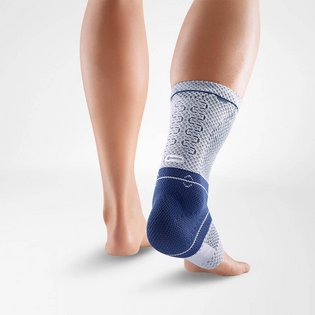
Achillodynia
What to do about Achilles tendon pain?
At 20 to 25 cm long and around 5 cm wide, the Achilles tendon is the thickest and strongest tendon in the human body. It connects the calf muscle (triceps surae muscle) to the heel bone (calcaneus). Its job is to transfer force from the lower leg to the heel. Achilles tendon conditions or injuries therefore always result in significant problems walking. Causes can include overstretching or a tear (rupture) of the tendon, as well as serious excessive strain, i.e. achillodynia.
What does a diagnosis of achillodynia mean?

Achillodynia is a common diagnosis that covers painful processes of the Achilles tendon. Those affected experience some level of pain in the tendon (i.e. between the heel bone and the calf muscles) and restriction of movement in the affected leg. In mild cases, achillodynia will subside on its own after a few days. If the pain in the Achilles tendon persists for a longer period, it is an indication of excessive strain.
In light of this, achillodynia is a common diagnosis among athletes, and is seen as a typical runners’ injury. Clear evidence for this diagnosis is provided by degenerative changes that are the result of long-term excessive strain or inappropriate mechanical stress. If the structure of the tendon changes, the blood and oxygen supply can be impaired, which impacts the healing process.
How does achillodynia manifest?
A typical symptom of achillodynia is pain in the back of the lower leg and heel that prevents patients standing on their tip toes. In addition, patients will be partly or completely unable to lift their toes off the floor because even slightly stretching the Achilles tendon will cause an uncomfortable pulling sensation. Climbing the stairs will also be painful. Furthermore, the tendon is sensitive to pressure and may become thicker; there may even be a crunching sound in some cases.
Achillodynia can occur in one leg only or both. In the long term, the Achilles tendon loses its stability and may rupture. An Achilles tendon tear of this kind is the most severe consequence of this degenerative condition.
How does achillodynia develop?
Achillodynia is a chronic process. This means that there is an increased risk of the condition recurring, even if those affected are no longer experiencing symptoms after temporary relief of the tendon. The following groups are especially at risk:
Good to know: runners as well as athletes playing ball sports are at an increased risk. The condition is more common in men than in women.
How is achillodynia treated?

Generally speaking, the affected tendon should be relieved and stabilized by a tape or support. Treatments that stimulate circulation can be used to combat inflammatory processes and promote healing. Pure pain medication should only be taken in cases of severe pain and in consultation with a physician, as it can obscure the actual condition of the tendon. After all, pain is an important warning signal, indicating that the load-bearing capacity of the Achilles tendon is significantly restricted and that severe consequences may occur if the tendon is not protected.
Athletes should avoid training for at least three weeks, even if the symptoms clear up sooner. Physiotherapy can teach patients how to stretch their calf muscles and the Achilles tendon correctly.
In addition to treating the acute symptoms, it is also important to clarify why achillodynia has developed and how to reduce the risk of it happening again in the future.
Achilles tendon supports: prevention and treatment
The risk of lasting damage caused by achillodyniais high because although the tendon is very resilient, its poor blood supply impedes full healing. It is therefore important to begin treatment and support the ankle during load phases as soon as symptoms occur, such as pain in the Achilles tendon region. Wearing ankle supports, such as the AchilloTrain and AchilloTrain Pro, has been shown to help.
In the acute phase in particular, the integral heel cushion of the AchilloTrain relieves the tendon. The integrated insert (pad) features two wings that massage the Achilles tendon while exerting pressure on the tissue, which promotes the drainage of swelling (edema) and improves circulation.
AchilloTrain®
Support for relieving the Achilles tendon
The AchilloTrain is a support that provides the Achilles tendon with relief. Find out more about its benefits and modes of action.
To product page
The AchilloTrain Pro support does not raise the heel. Instead, the pad acts not just on the tendon but also on the transition to the calf muscles, which improves metabolism in the area, activates the muscles, and improves coordination. That is why it is also used as a therapeutic tool after tearing the tendon and subsequent surgery to support the healing process during the mobilization phase.